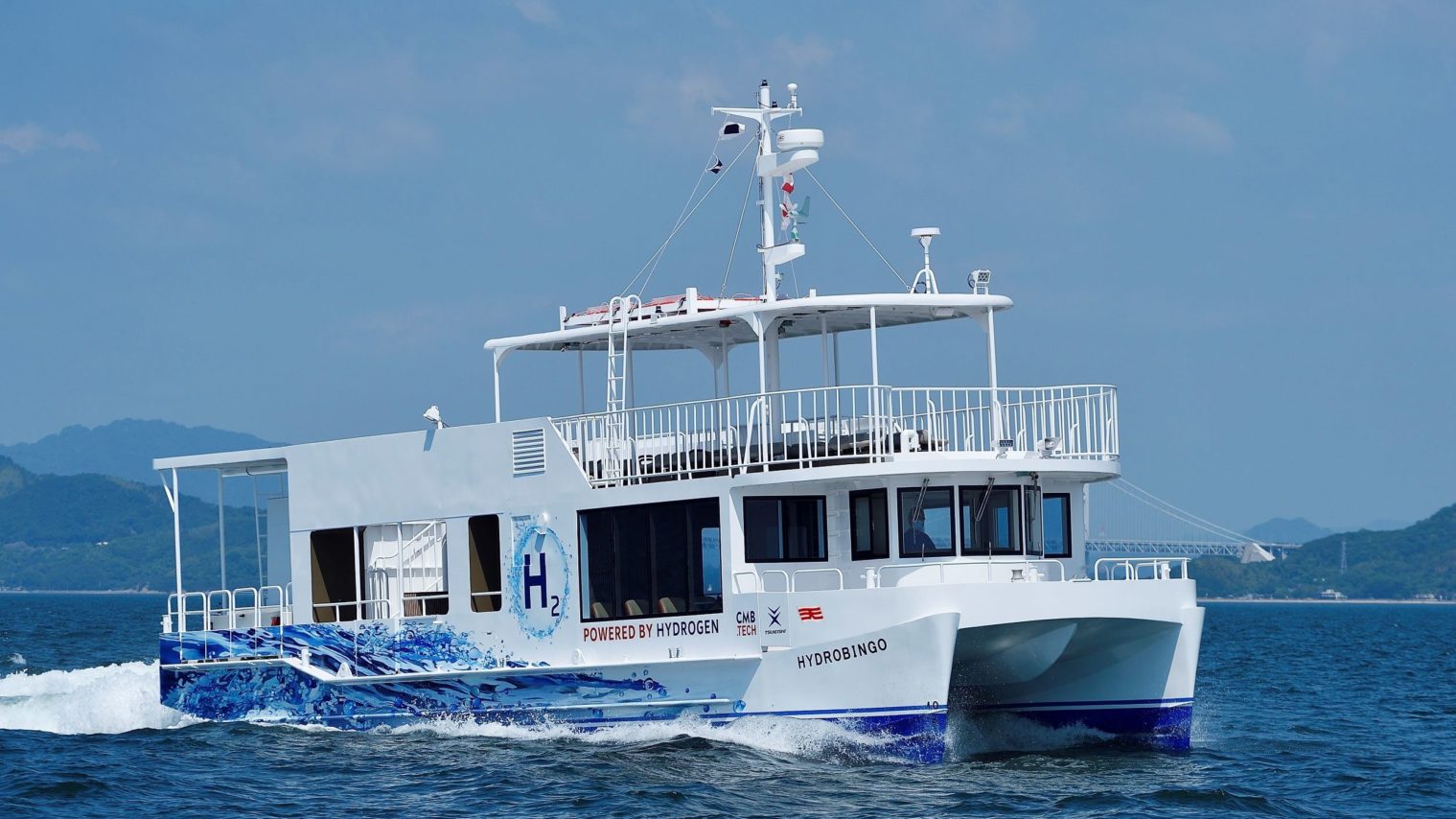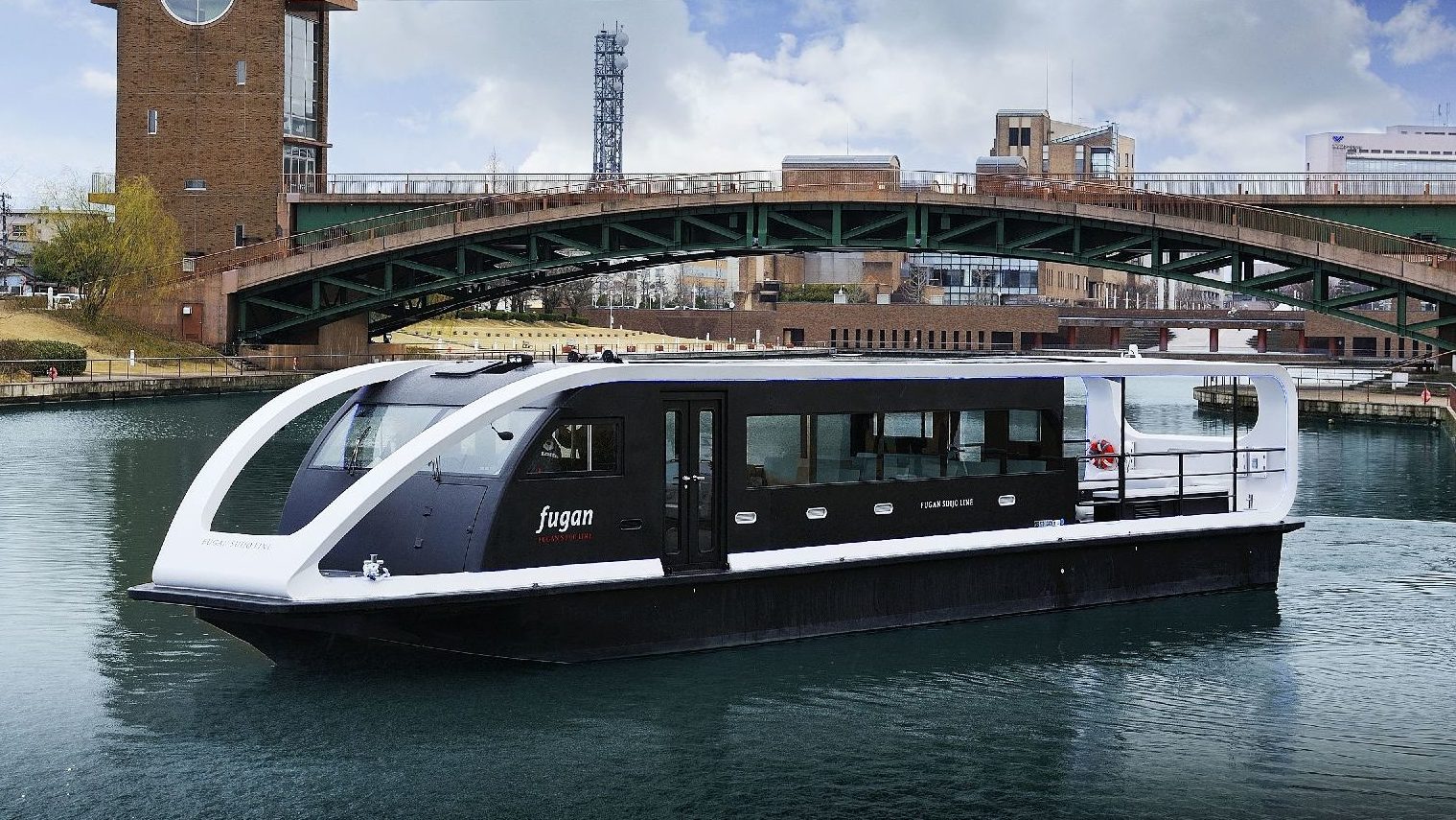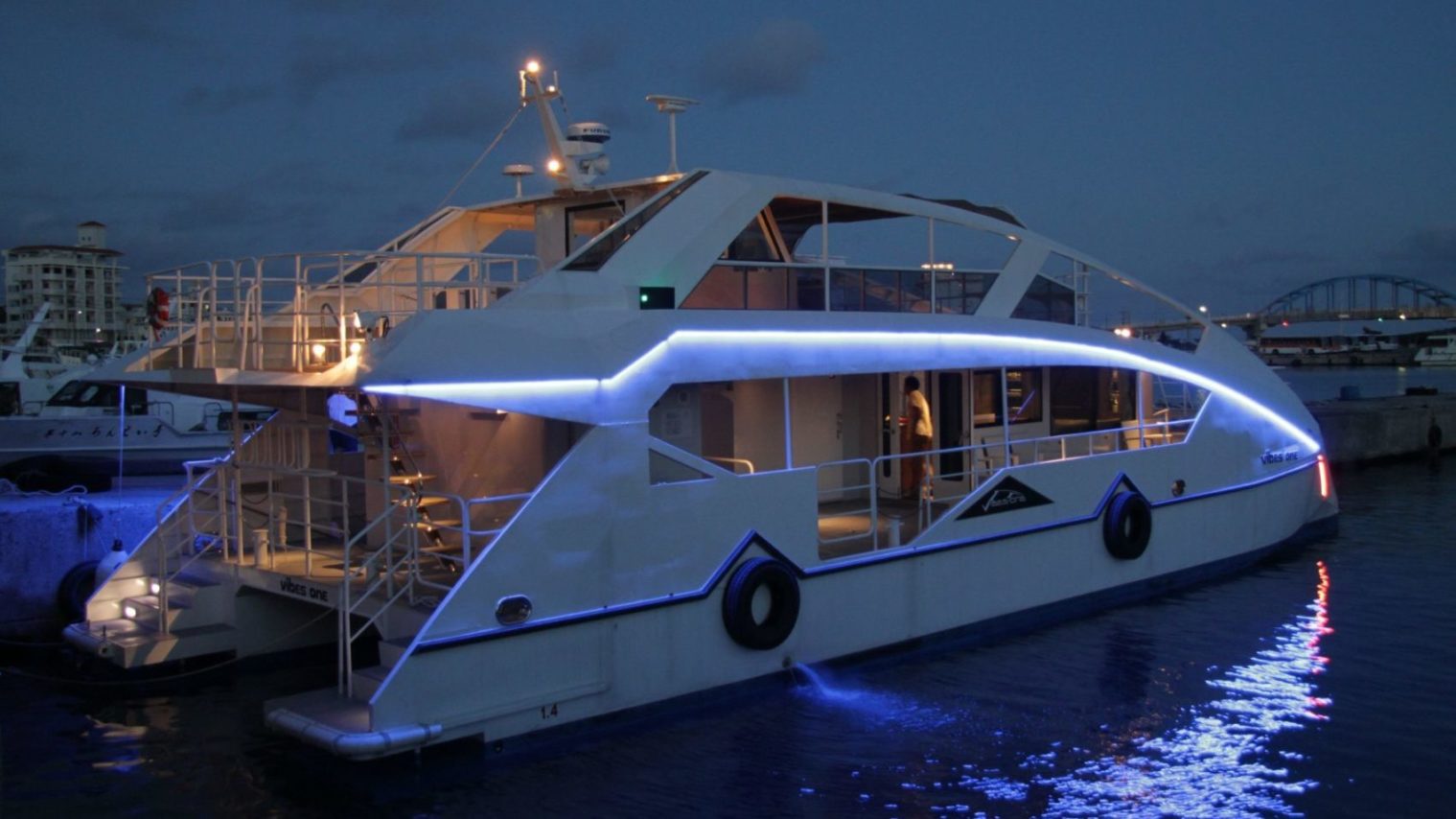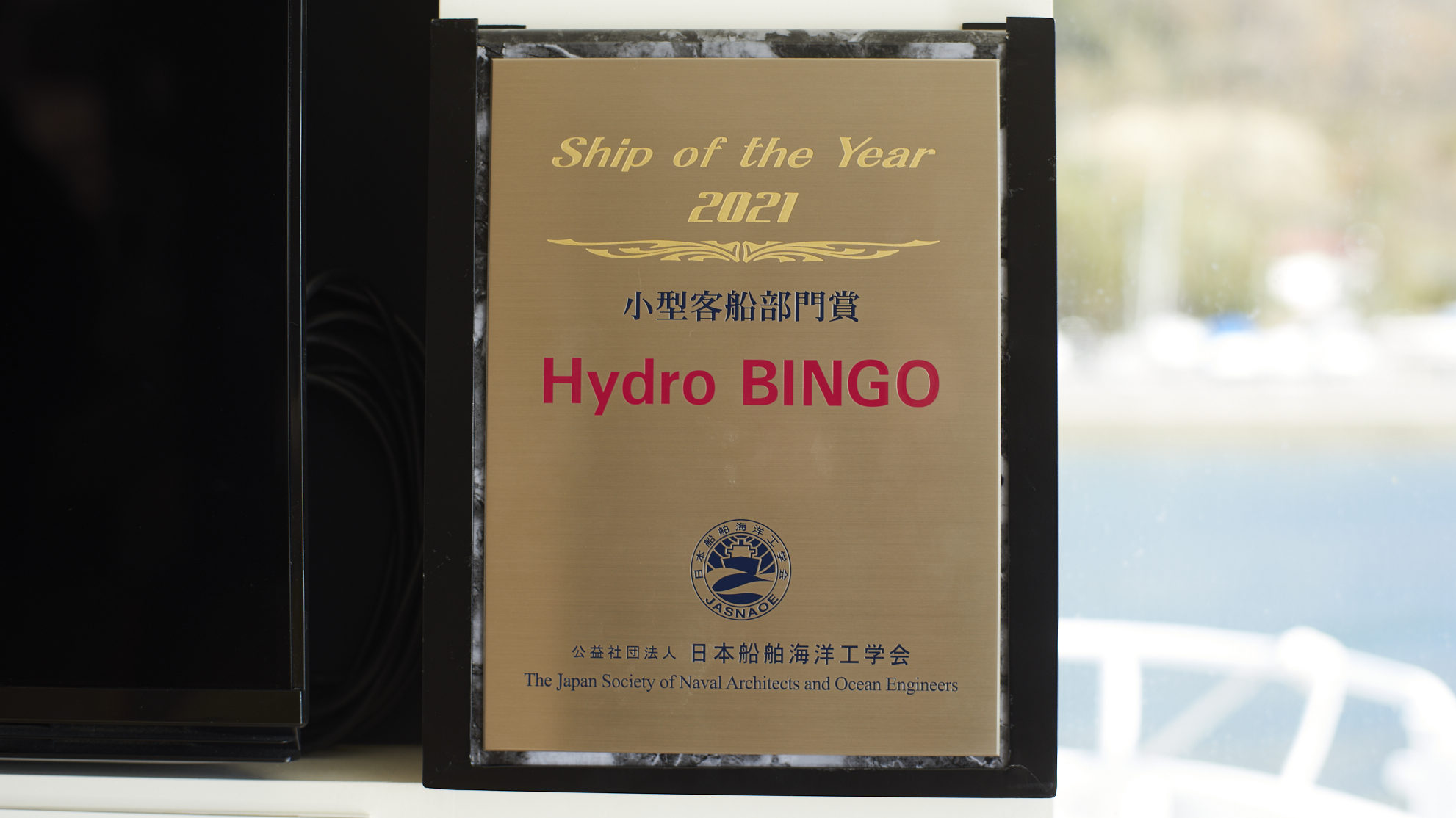PROJECT STORY
Setting a Precedent and Bringing the Future Closer Developing the World’s First Hydrogen-Powered Vessel
How the World's First Hydrogen-Powered Passenger Vessel Was Built
Hydro BINGO, the world’s first hydrogen-powered passenger ferry, was completed on July 12, 2021. Hydrogen represents one of the most promising next-generation energy sources for the coming carbon-neutral era.
However, the journey to a hydrogen-powered world is far from complete,*1 and various regulatory gaps still remain. Despite a range of hurdles that stood in the way of project completion, how did TSUNEISHI FACILITIES & CRAFT create the world’s first passenger vessel equipped with a hydrogen-powered engine? Here is a look at the company’s approach and efforts.
*1 Hydrogen-powered world: One in which the use of hydrogen is an integral part of economic activities and the daily lives of citizens
A specialized small vessel manufacturer creating new value with original ideas
TSUNEISHI FACILITIES & CRAFT (TFC) is a shipbuilding company that builds and repairs small aluminum alloy vessels. While this craft business is TFC’s main area of operations, it also engages in general construction, and lifeboat maintenance and inspection.
The company’s craft division builds ships based on unique design specifications for each vessel. It produces a wide variety of small vessels, including government ships such as customs patrol boats, fire boats, pilot boats and other work boats, as well as high-speed passenger vessels that connect remote islands with mainland ports.
In recent years, TFC has launched a series of pivotal vessels in preparation for a new era of decarbonization, such as zero-emission ships powered by batteries. The company has earned the Ship of the Year award multiple times, as part of an award program sponsored by the Japan Society of Naval Architects and Ocean Engineers. TFC is known in the industry as a company that builds unique, advanced ships.
It has earned the Ship of the Year award multiple times, as part of an award program sponsored by the Japan Society of Naval Architects and Ocean Engineers. Hydro BINGO also won the Small Passenger Vessel Category Award in 2021
Taking on the challenge of powering ships with hydrogen and exploring the potential of new energy sources
When TFC began to consider new energy sources for powering vessels as part of its efforts to help build a low-carbon society, the company first turned to electricity. Built in 2012, the Amanokawa was Japan’s first passenger ship powered by an electric motor paired with lithium-ion batteries, and it has been mainly used as a sightseeing boat. Three more electric propulsion ships were built, but their use was limited to carrying sightseers. After repeated vessel construction efforts, it was determined that lead-acid and lithium-ion batteries could not be widely used for commercial ships carrying heavier loads.
Consequently, hydrogen fuel cells emerged as the next strong candidate for a new vessel energy source. While light fuel oil is widely available through a well-established distribution network, hydrogen is only available from limited providers. Moreover, it is difficult to obtain sufficient output from these fuel cells.
The development team then came across a dual-fuel engine operating on hydrogen and light fuel oil, developed by Compagnie Maritime Belge (CMB), a major Belgian shipping company. Using both hydrogen and light fuel oil ensures the vessel can continue operating even if the supply of hydrogen is interrupted for some reason. If the team were to build their own dual-fuel hydrogen vessel, they knew they would need to find engineering rules regarding the use of hydrogen. They finally realized they could take a step toward powering ships with hydrogen. Thinking about the future had primed them to come up with an insightful idea.
In 2019, TFC signed an agreement with CMB to commercialize the world’s first hydrogen-powered passenger ferry, and a joint ship-building project involving Japan and Europe began.
Ushering in the era of hydrogen-powered ships with no precedents or design rules to follow
Safety was the primary challenge in designing a hydrogen-powered ferry. The team needed to prevent hydrogen leaks from pipes and tanks, and install safety partitions.
Normally, rules and standards are followed in order to ensure safety when designing ships. However, the government and relevant industry groups have not yet established any rules for designing vessels powered by hydrogen. Therefore, in order to determine objective standards, TFC set up an internal risk assessment committee, and established valid design assessment criteria based on the opinions of external experts and others. The team proceeded with the design, and approval was obtained from the inspection agency at each stage.
Still, this was an unprecedented design challenge, and since it was a relatively small vessel of 19 gross tons with little space, the designers had to redo the pipe layout more than 30 times to ensure the placement was safe.
Another challenge faced by the project was the pandemic travel restrictions that were in place. During the construction process, engineers from the project partner, CMB, were unable to fly to Japan due to the COVID-19 pandemic. When it comes to tuning a dual-fuel engine, the skills of an experienced engineer are essential. Since TFC had never done this work before, after performing the engine settings, the team had to report to CMB engineers in the UK for confirmation. Then further adjustments were performed based on the response, and the process was repeated multiple times. Thankfully, all of these hurdles were overcome thanks to the enthusiasm of the TFC employees, who wanted to create a world-first vessel, and at last the ship was successfully completed.
Hydro BINGO engine and interior
Doing it ourselves, rather than relying on others
On July 12, 2021, the Hydro BINGO, the world’s first hydrogen-powered passenger ferry, was completed. One week later, ship classification organization Nippon Kaiji Kyokai (ClassNK) provided TFC with certification based on this achievement, namely, an Innovation Endorsement Provider Certification for organizations.*2 Many people tend to think that a hydrogen-powered world is a concept for the distant future. However, unless someone takes the first step, the future will never take shape. Now, as a certified organization for producing innovation, TFC will build on this success by continuing to take on new challenges.
*2 Innovation Endorsement is a certification service established by ClassNK, in operation since July 2020, to promote the spread and development of innovative technology. The evaluation process is conducted quickly based on appropriate standards established in collaboration with front runners who are technological pioneers. One of the certification categories available, provider certification, is for organizations such as companies. It certifies the efforts of companies to transform their business methods and organization to create a sustainable and competitive enterprise, while pursing ESG management and the SDGs.









